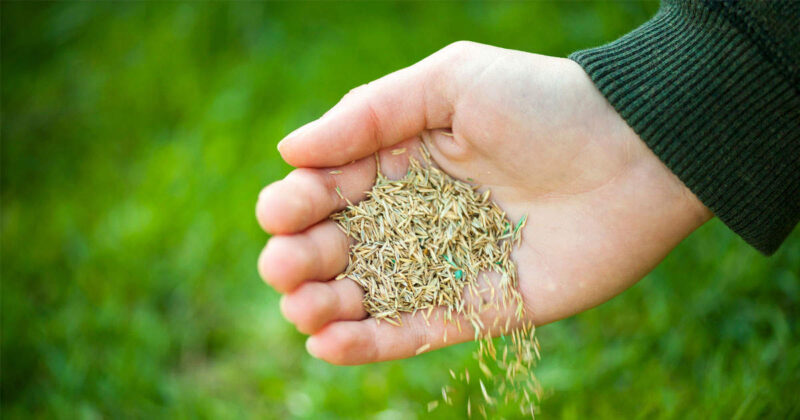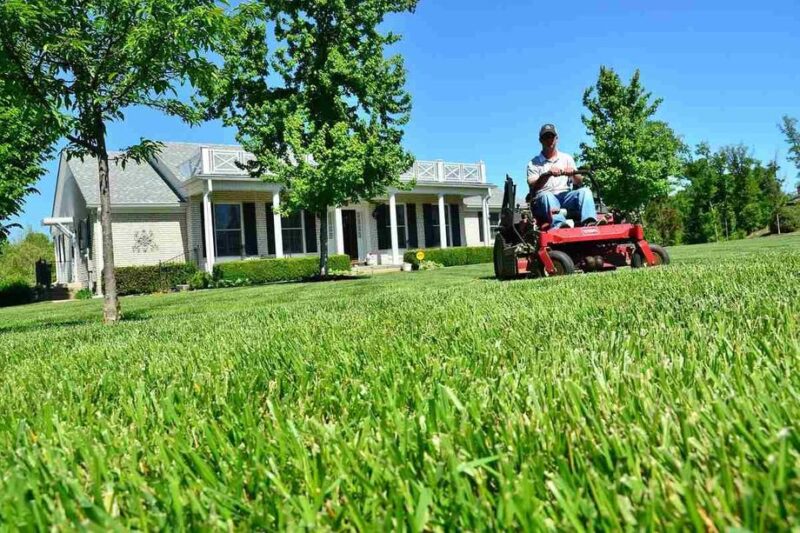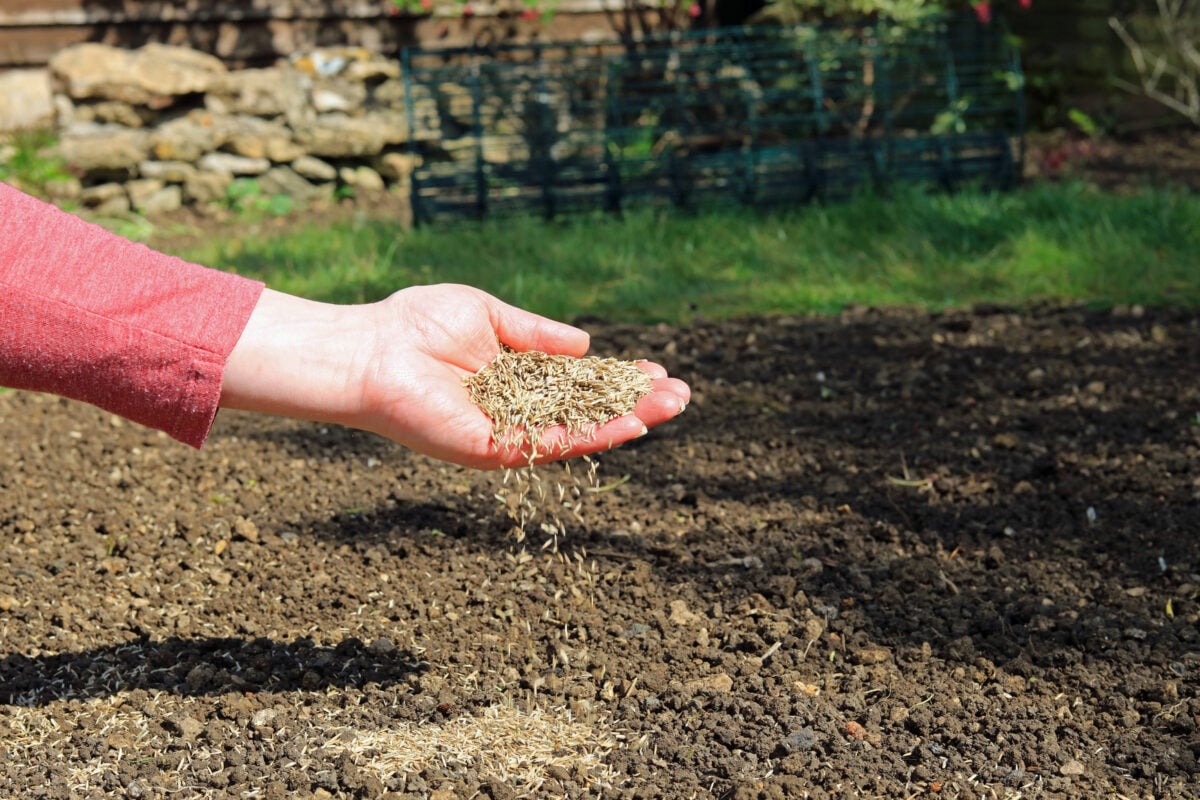Is your yard starting to look a little patchy and bland? If so, planting grass seed is a great way to spruce it up! With the right tools, techniques, and know-how, you’ll be able to enjoy your lush, green lawn in no time.
In this guide, we want to teach both beginner gardeners and experienced lawn-care pros the proper way to seed a lawn so you can enjoy healthy, vibrant grass!
Before You Start Planting Grass Seed
There are a few things you should take into account before you start planting grass seed:
- Your soil’s health plays a critical role in the success of your grass growth, so you should test your soil and add amendments before planting, if necessary.
- If you have applied herbicides recently (in the last month), it could prevent grass growth
- Be sure to choose the right grass type for your area for optimum growth
- Every type of grass has its own ideal growing conditions
To start, make sure your soil is healthy and you’re working with the right type of grass. Also, take into account the time of year— does your grass species thrive a the time you plan to seed? Once you have the details ironed out, you’ll be on your way to a lush, beautiful lawn.
Use the Right Type of Grass Seed for Your Area
Grass is categorized as either cool-season or warm-season, so the first step to successfully planting grass is to choose the right type for your area.
Cool-season grasses grow best in cold regions because they thrive in moist, cool environments. They can germinate in colder soil better than warm-season grasses. Some common cool-season grasses are perennial ryegrass and fescue.
On the other hand, warm-season grasses, such as Bermuda and zoysia grass, tolerate drought and hot weather better than their cool-season counterparts. However, they won’t germinate in cold soil. The type of grass you choose to plant should reflect the climate in your area.
Depending on your grass type, your lawn may go dormant at times throughout the year. Cool-season grasses can wither in the summer heat, and warm-season grasses turn brown in the winter.
Choose the Best Time of Year
The best time to plant grass seed is when your new grass will have time to germinate in its ideal conditions. Grass needs time to establish strong roots before it’s subject to harsh weather, so you should plant seeds at a time that corresponds with the grass type. In warm zones of the U.S., the best time to plant grass is in the spring, and in northern regions, the best time to plant grass is in the fall.
For cool-season grasses, fall is the best time to plant, however, they can also be planted in the spring. If you plant in the spring, they will germinate and grow, but you will need to water them frequently during the summer to avoid scorching in the hot weather.
Supplies You’ll Need to Plant Grass Seed
You can have endless knowledge of how to plant grass, but having healthy soil and the right materials is just as important. Choose good-quality grass seed, fertilizer, lime, and soil amendments.
Grass Seed

To start, purchase a quality seed that’s suited to your climate. For example, choose a warm-season grass if you live in a warm climate, a cool-season grass if you live in more northern regions, or a blend of the two that’s made for your area. It’s also important to use grass seed mixes designed for home lawns. With a bit of research, you can find the best seed mix for your yard.
If you want to conserve water, choose a drought-resistant seed mix. If your yard is full of shade, consider planting seeds developed specifically for low-light areas.
There are also seed mixes that include starter fertilizer or a filler product for even distribution. However, it’s best to avoid mixes that include herbicides, which can cause harm to new grass seedlings.
Fertilizer and/or Lime
One of the most important factors in the success and growth of your grass is the health of your soil. Grass grows best in environments with a pH between 6.0 and 7.5 and that contain a balance of nutrients. It requires the right combination of oxygen, hydrogen, carbon, nitrogen, phosphorus, and potassium for optimal growth.
Don’t skip on determining the health of your soil, even if you see signs that it’s healthy. Conducting a soil test is the only way to be sure that your soil doesn’t need any amendments, and if it does, the test will tell you exactly what to add.
Contact your local extension office to obtain soil test kits and locate testing facilities near you.
Lawn Soil or Turf Builder

Healthy soil is made up of the right combination of organic matter, good structure, excellent drainage, balanced nutrient levels, and sufficient microbial activity. Once you’ve determined your soil’s health and added nutrients to fix deficiencies, if any, you should add lawn soil or turf builder to enhance the soil’s structure.
Lawn soil amendments ensure the proper drainage levels to avoid washing away nutrients, allowing your new lawn to grow faster and stronger.
Soils that contain a lot of clay can become compacted, which can prohibit oxygen from getting into the ground. On the other hand, if your soil is too loose and sandy, nutrients can get washed away when you water or when it rains.
Using lawn soil or turf builder adds organic matter to your soil, which solves both problems.
Seed Spreader (Optional)
You can use a seed spreader to make seeding your lawn much easier and ensure even distribution of the grass seed. While it is an optional step, it’s highly recommended, especially for large areas.

For residential use, broadcast spreaders help you spread seeds, fertilizer, and other lawn products. Many landscaping professionals opt for high-quality, commercial-grade broadcast spreaders since they get much more use and hold up in the long run.
Another option for lawn care pros is a stand-on sprayer, which features zero-turn maneuvering and the ability to spray both liquid and seed on large landscaping jobs.
How to Seed a New Lawn
Follow these five steps when planting grass seed for the best results:
Step 1: Prepare the Soil
First, remove any existing weeds and debris, then till the soil to around three to four inches deep. This process aerates the soil and removes any large clumps.
Be sure to keep the soil as level as possible, and if necessary, add contours to promote drainage away from your house.
Step 2: Add Nutrients, if Needed
Test your soil and add any fertilizer or amendments to give your lawn the best start.
Step 3: Plant the Grass Seed
Spread grass seeds in a crisscross pattern evenly over the soil. Then, rake the seed into the top layer, keeping the ground as level as possible.
Step 4: Protect the Grass Seed
Rake the area again to make sure your grass seed is covered by more than 1/4-inch of soil. Use an erosion mat or light layer of weed-free mulch to protect your grass from seeds, birds, and heavy rains.
Step 5: Water the Seed
Water your newly planted seed thoroughly until your grass is established. After it starts growing, water it lightly two to three times per day, tapering off of the schedule as your grass matures.
How to Overseed an Existing Lawn
In warm regions, you can use cool-season grasses to overseed your lawn in the winter to keep it green. To overseed an existing lawn, follow these steps:
Step 1: Prepare the Existing Lawn
Cut your grass shorter than usual to prepare for overseeding. Bag the clippings and rake the grass to thin out the turf.
Step 2: Prepare the Soil for Growing Grass
Grass seeds need a combination of light, moisture, and soil to grow. First, aerate your lawn, then spread compost over the area you want to overseed. Rake in the compost evenly, and then spread a starter fertilizer overtop.
Step 3: Seed the Lawn
Spread the grass seed according to the rate recommended on the packaging, then rake it loosely into the soil.
Step 4: Protect the Grass Seed
Spread another thin layer of mulch or compost over your new seed to protect it. Another option would be to use an erosion control blanket to protect it until it has sprouted.
How to Seed Patches in Your Lawn

Lawns can develop patchy or bare spots for several reasons, including poor soil conditions, fungal infections, or diseases. The good news is that it’s easy to patch your lawn in just a few steps!
The process is similar to planting new grass seed for an entire lawn. Start by preparing the soil by removing debris and damaged grass. Loosen the dirt around 6 inches deep, and around six inches into the surrounding grass. Then add a layer of compost or lawn soil and level the area.
Next, spread the seed evenly and lightly, and then rake the seed into the ground. Water the area thoroughly and keep it moist until the seed takes root.
For larger damaged areas, sod works best. To plant sod, prepare the soil the same as you would for seeding, but remove excess soil to keep the sod level with your lawn. Once it’s been laid down, walk gently on the sodded area to ensure the roots make contact with the ground underneath.
What to Do Before the Grass Starts to Grow
Now that your grass seed has been planted, the only thing it’s missing to develop into a lush, green lawn is water.
Water your new lawn at least once a day, but depending on the weather, you may need to water two or three times per day. Keep the top layer of soil moist until your grass is at least an inch tall.
However, be careful not to overwater, which can cause seeds to rot, or wash them away before they take root.
Monitor Seed Growth
Once your new grass starts to germinate, monitor its growth and assess its water requirements. The process from planting seeds to becoming fully established takes around two to three months. During this time, your lawn will be vulnerable to extreme temperatures, harsh weather, and heavy traffic.
If you notice any bare spots, this is the best time to plant extra seed in those areas.
Mow and Maintain Your New Grass!

Once your grass reaches around three inches, congratulations, it’s ready to be mowed!
The first time you mow your new lawn, set the blades on the higher side. Continue to protect your grass from heavy foot traffic during its first year. After around four to six weeks, you can start fertilizing, but wait around three to four months before using herbicides or harsh chemicals.
Grass Seeding FAQs
How long does new grass seed take to grow?
Germination depends on a combination of sunlight, moisture, and weather conditions. Some grass can germinate in as little as five days, but it may take up to 30 days. At this rate, it will take around three months before the grass is established enough for mowing.
Can you just sprinkle grass seed on top of your existing lawn?
Sprinkling grass seed on top of your lawn will not yield the best results unless you prep your lawn properly. Skipping the prepping stage will result in low germination and the seeds will not take root in the ground.
Will grass seed grow if I just throw it down?
If you throw grass seed down, there’s a chance it will grow. However, if you take the time to prepare your soil, you can be confident it will grow. Following the preparation steps results in a lush, green lawn, but throwing seeds down leads to weak, patchy growth.
Will grass seed germinate on top of the soil?
Grass seeds will germinate on top of the soil, but this germination must be followed by root development. Spreading a thin layer of soil on top of the needs will protect them from the elements and keep them in place. Seeds also need consistent moisture to germinate, and soil holds moisture. Seeds that dry out can die before they have the chance to develop roots.



